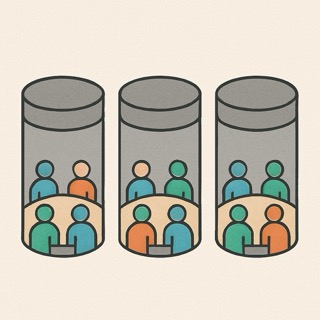
You wouldn’t try to design a product by focusing on one piece at a time. The best products in the world solve problems by reimagining, not by incremental improvements. So why, with AI as the largest technical innovation in recent history, are so many products focusing on improving each step individually, when we complete work in teams?
You may be saying “What are you talking about? AI is redefining industries right now!” I hope to convince you that many AI implementations are myopic, local optimisations.
Instead, we should design AI solutions for teams and their jobs-to-be-done: not just copilots, but full AI team members. This radically differentiates your product and its impact on your customers.
The productivity mirage
Shiny object syndrome is inhibiting productivity. Well, it’s killing team productivity. Yes, there is merit in generating code 20% faster or using chatbots to streamline your customer service, but we need to zoom out and look at entire workflows if we want to move past incremental gains.
Right now, we’ve got a bunch of silos, in the form of tools – this tool optimizes one bit, that tool optimizes another bit. But almost no one is reimagining the entire business process with AI. It’s like having a Formula 1 pit crew where we upgrade only the drills for the lug nuts. Sure, the tires get changed faster, but the overall pit stop isn’t much quicker, is it?
There’s an irony in the fact that we’ve spent decades trying to get rid of secretarial work, then AI comes along and what happens? We all become secretaries to the AI. Think about it – you do your work in one system, then manually copy it into the AI’s chat window, then take what it gives you and manually put it back into your actual workflow. That’s not AI helping you – that’s you helping the AI.
And why? Because we’re building these siloed task-level automations rather than thinking about entire workflows. The real magic is when AI helps carry context throughout your entire workflow, facilitating handoffs and eliminating those wait times. That’s what actually speeds up delivery and creates business value.
AI should adapt to humans, not vice versa
Changing the way humans work and moving them away from what they’re good at yields poor results. Instead, you could write code to adapt AI to the processes that humans do best. You want a process that keeps humans in flow where they perform the best and makes it easy for the humans to outsource work to the AI that the AI does best. Basically, you should revisit good Service Design and systemic thinking, redesigning assuming that an AI is engaged throughout the process.
If you ask humans to become secretaries to the AI or to change the way that they work best in order to facilitate the AI then you will not get anywhere near an optimal solution. This is analogous to entering work orders into a spreadsheet, or digitizing the work orders to begin with.
Why 80% across everything beats 95% in one area
It goes back to the handoffs and also to the ability for a human being to think about a solution as an end-to-end process rather than as a sequence of steps – at least, if you take that step back that so few are taking. Humans and businesses think about solutions as end-to-end and it’s easier to express the requirements and constraints and optimize across that entire process than it is to debug and optimize bit by bit. Redesigning actually is faster, easier and more effective.
This is doubly true in an AI-assisted environment where AI helps you write code and can understand the process intrinsically end-to-end. The AIs already can handle a huge amount of complexity, so challenging them with more context is not usually a limitation. In fact, providing comprehensive context enables AI to make more intelligent decisions across the entire workflow. When AI understands the full scope of what you’re trying to achieve, it can optimize for the overall outcome rather than just the immediate task.
The shift from developer to team experience
Team experience, in contrast to developer experience, shifts focus to crucial metrics like team throughput and time to resolution, which directly impact competitiveness, agility, and time to market – factors often disconnected from individual developer productivity. I often see the most fine-tuned engineering teams still struggle to markedly speed up product delivery, all because their perfectly optimised silo of productivity can’t affect enough of the wider workflow.
The right AI – the AI you actually need in your organization – can efficiently retrieve context, generate initial code and tests, and summarize this work for the team, ultimately improving team efficiency and reducing cognitive load. And it’s integrated in your tools and processes. AI needs to be integrated across these workflows, and across these tools.





